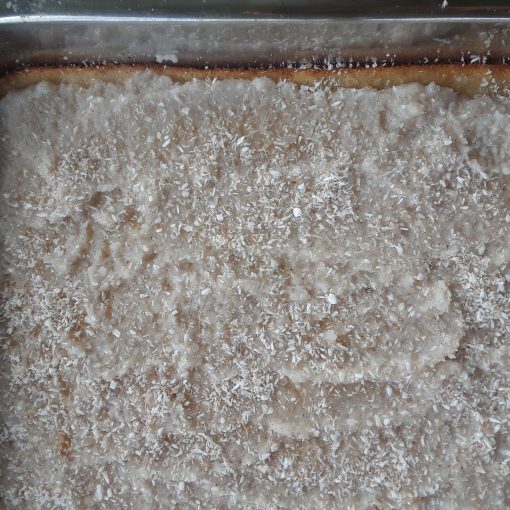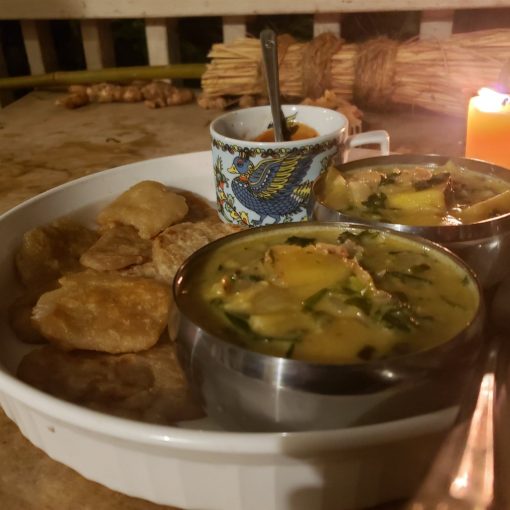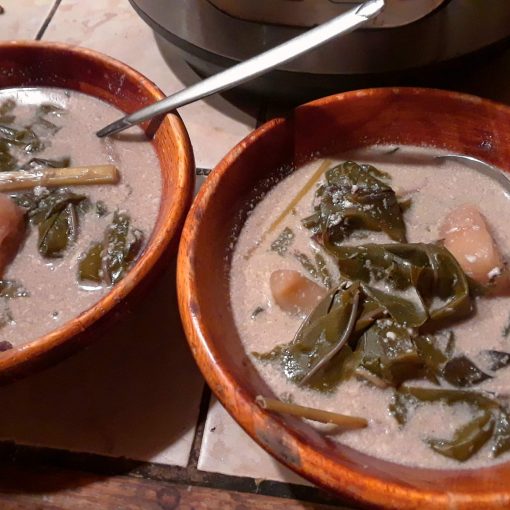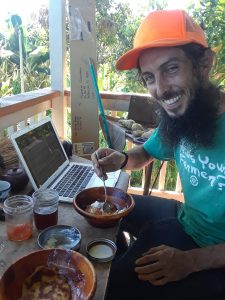
This recipe is simply two of our favorite things combined. Pa’i ‘ai (pounded kalo) and sourdough pancakes. I am pretty sure Drake would eat ANY and ALL pancakes offered to him, but I myself prefer a well soured cake, and I think he enjoys them especially too. Combined together, pa’i ‘ai and sourdough create a highly nutritious and filling breakfast, lunch, or dinner 🙂 Plus, pancakes are very romantic. (Thanks to Jack Johnson)
What does sourdough and pa’i’ai have in common? First of all, they are both fermented foods. Colonized by billions of living, breathing tiny creatures. Sounds appetizing, right? And second, they both are made very simply, with essentially only 3 ingredients: starch, water, and microbes.
Despite the almost ubiquitous myth that you must inherit a sourdough starter or buy one from a bonafide bread company, you can actually make your own (delicious and fully functioning) in about a weeks time. I think it is very cool that some families keep a sourdough starter that has been passed down from generation to generation–and perhaps an older starter is somehow superior–but for me, I had no great-great-grandmother starter, so I cultured one myself, and I think it’s pretty maikai’i. (Means “good”)

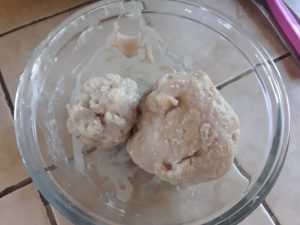
Pa’i ‘ai, on the other hand, is cooked kalo (commonly known as taro), freshly pounded against a poi board (papa ku’i ‘ai) with a wetted stone (pohaku ku’i ‘ai) until the corm comes smooth and soft. The very act of pounding kalo, is like lighting a fire that causes a procreative expansion of microorganisms, which kick start fermentation. This is the magic of homemade poi or pa’i ‘ai. The stuff you’re served at restaurants, or buy at the store, has been ground smooth in a blender, and can never compare. Before I’d tried ku’i kalo (traditionally pounded) I had no taste for poi at all. I really, really wanted to like it, but couldn’t. UNTIL I TRIED THE REAL STUFF. And then I made no effort to like it. Real poi is living food. When I take a bite of well fermented poi I feel my energy uplift, even before I’ve swallowed–it’s almost like taking a shot of coffee in its instantaneous effect, but of course the energy of kalo is much, much different. Real poi is powerful medicine that makes my body keep asking positively for more…
But today I’m sharing a recipe made with pa’i ‘ai. Pa’i ’ai is what you make first before you make poi. It is not as finely pounded or smooth as poi, and its water content is much lower. Thus, it is perfect for putting in pancakes.
Prepare to Make Pa’i ’ai
- Grow your own kalo or find a reputable source
- Pressure cook or steam kalo. Check which variety you’ve got and make sure to cook it long enough. If you have any doubts, before you go ku’i potentially under-cooked kalo, chew a small bite and wait a minute to see if the oxalic acid is gone. In our InstantPot is takes between 45 minutes to an hour depending upon the variety and how full the pot is. FYI, it is best to steam kalo in large quantities as it takes so long to cook.
- After kalo has cooled, gently peel the skin off and the first millimeter of flesh beneath. This inner/outer crust is called the koina (meaning extra). It contains more sugar than starch and for the best tasting pa’i ‘ai or poi it should be removed.
- Now, here is the tricky part… A pohaku ku’i ‘ai (the special stone tool to pound poi) is ideal, and it is hard to think of any home kitchen tool for which to substitute. It is not impossible to find a rock shaped like this on the island… However, if you don’t want to go holoholo for pohaku ku’i ‘ai in the deep forests or river beds of Hawai’i, consider getting one made by Daniel Anthony on O’ahu. This is the only source of purchasable pohaku that I know of. You can also have a custom papa ku’i ’ai (poi board) made as well. It is well worth the investment especially if you are ready to ku’i your own poi. You can reach him at his business website https://manaai.com/pages/talk-story and drop a message in the “Talk Story”… For now, we use our largest wood cutting board and it suffices.
If you already have what you need you probably already know how to do this. If you are a newby, firstly, I suggest finding someone to teach you hands-on. If that is a challenge then try to follow my instructions:
HOW TO KU’I
- Set up your poi board either on the ground or a table (if sitting on the ground get a towel or cushion for your butt or knees
- Have your peeled, koina free kalo at the ready in a bowl on one side and a smaller bowl filled with water on the other
- Wet your hand in the water and slap the bottom of your pohaku–this is the way you “add” water–and begin to pound your kalo. To start off I apply pressure to the kalo from above, at an 80-ish degree angle. After you get it going you are going to “pound” at more of a 30 degree angle. The word “pound” can be a little misleading… To ku’i is more of a smearing or spreading action, though it does take some force. The goal is to spread the kalo so it binds or gels with itself.
- Continue to ku’i and to slap your stone with wai (water) until you have a finished product that you like.
If you aren’t going to use the pa’i’ai that day you can place it in a bowl on the counter and cover it with a cloth. While well made poi can sit out un-refrigerated for days (and tastes better as it gets older) pa’i ’ai can be put in the fridge to prevent molding. Refrigerating will not ruin the product, as I personally feel it does with poi.
Now you can eat your pa’i ’ai just as it is, pan fry it into little burgers, or add it to sweet or savory pancakes. Or invent something new!
NOW you are ready for the SOURDOUGH DOWNLOAD!!!!!
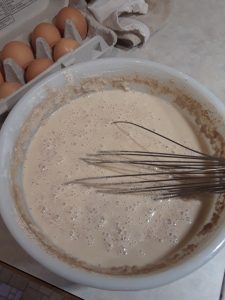
Capturing wild yeasts to make sourdough is fairly simple:
- Pick out a wide mouthed pint size mason jar to store your starter in
- Add ¼ cup flour and ⅓ cup water; mix well.
- Add a breathable lid (cotton cloth or paper towel works well with a string or rubber band) then place in a warm area with good airflow.
- Feed at least 1 teaspoon of flour with a splash of water every day. If you feed it twice a day (morning and evening) it will grow faster. Stir well and occasionally talk to the yeasts and thank them for helping you digest your grains better. When your starter is ready to use it will be loftily thick with air bubbles and have a delightful sour smell to it. This means the microbial population is very high and you should use it to ferment your bread or pancakes.
- Store in the fridge and ideally feed every week or every other a heaping spoonful of flour and water to balance.
Which brings us to the culminating combo of PA’I ’AI PANCAKES
Ingredients needed:
- 1 cup sourdough starter
- 2-3 cups of flour
- Water
- 2-3 tablespoons oil
- 1 teaspoon salt
- 1-2 eggs
- Pa’i ’ai
Steps.
- In the evening before your pancakes breakfast, take out your sourdough starter (you should have at least 1 cup) and empty the whole thing into a mixing bowl with 2-3 cups flour. Measure flour accordingly based on how many mouths you’re feeding. Add water and mix thoroughly. I don’t measure how much water I use, I just add until I’ve got a good pancake batter consistency: not too runny but not too thick; light enough that bubbles will form when it cooks. Cover the bowl of batter with cloth and let sit on counter top overnight. Sometimes I start fermenting my batter well in advance and let it sit out on the warm lanai with the breeze and the sunshine. I love a loooong ferment for the sour taste and digestive ease.
- In the morning (or whenever you’ve scheduled your pancakes) you will take a look at your batter and hopefully see a surface covered with small bubbles. Remove ⅓ of the batter and return it to your initial starter jar. (Feed your starter on the counter like you did in the beginning, for the next week until you have at least one cup to store again in the fridge.) With your pancake batter remaining add oil, eggs, salt and pa’i ’ai (or if no pa’i ’ai than bananas or chocolate chips…)
- Heat skillet, add oil, and fry them delicious cakes to golden brown perfection
- Eat them with someone special and praise Akua.

A NOTE ON FERMENTED FOODS:
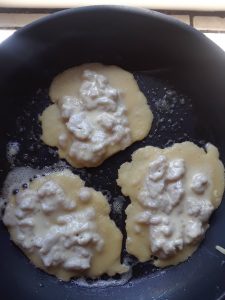
Many folks advocate for eating fermented foods (myself included), but not everyone knows or understands exactly why. What’s the point of spending extra time culturing microorganisms to inhabit our foods if they taste just fine without them, and sometimes even better? Are fermented foods really easier to digest? Why are fermented foods easier to digest? Why should I care to eat them if my digestive system is doing just fine without? If you are the person asking these questions I have two words for you. PLANT TOXINS.
Hundreds of different foods, including ALL grains, legumes, nuts, (most) seeds and nightshades contain harmful plant lectins, i.e., toxins, which reek havoc in our gut (whether we noticeably feel it or not). In order to fully enjoy the whole nutritional benefits of these plants in our lives they need to be processed correctly and the lectins eliminated as best as can.
The modern industrial standards have eliminated the process of eliminating lectins. The beans you buy in a can were never soaked or fermented before they were cooked and packaged. The “Wonder Bread” that you can get so cheap practically anywhere was not allowed to ferment for 24-72 hours with wild yeasts, the minimal standard of our bread/grain-eating ancestors. Almost all our processed foods have lost their original nutritive power from industrial corner-cutting to make everything standard, uniform and timely. Subsequently we are a sick and constipated nation as a whole.
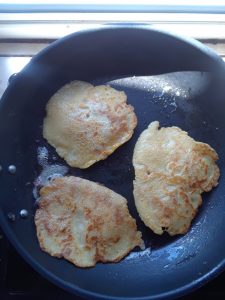
Really, nutrition begins with the way we farm and health of the soil, but the problems do compound when we don’t fully process or prepare our food correctly either. Typically, chronic illness begins with a digestion problem most likely due to diet. If you are not fulling absorbing nutrients from your food or properly eliminating waste it is going to take a toll on your overall wellness, weaken the immune system and lead to disease. That ancient Greek physician, Hippocrates, said that All disease begins in the gut, and I believe him. It’s clear to me from personal experience that a healthy, fully functioning digestive systems equals happiness. Pooping well (frequently and comfortably) is one of the simplest joys of life that should never be taken for granted! It means you ate, you didn’t starve, your body received nutrition and it’s now eliminating the waste. Let’s all have a round of applause for our bodies’ and gut microbes!
My digestion, however, has not always been as regular or as optimally functioning. At the age of 15 I developed an intolerance to dairy, corn and gluten, among thousands of others. WHY? Does anyone really know? I believe my allergies were cause by a few compounding factors. 1) from the chemicals sprayed on wheat before and after harvest, which when consumed by people destroys our gut microbiom and 2) synthetic hormones and antibiotics given to dairy milking cows, which further kill our gut microbes. And 3) due to harmful plant lectins from conventional quick yeast risen breads.

These two first reasons I mentioned were no-brainers to understand. It all made sense to me when I permanently fixed my dairy intolerance by taking a KNF probiotic drink of concentrated lacto bacillus microorganism (commonly know as L.A.B., “lab”, or Lactic Acid Bacteria.) That highly powerful and benevolent microbe not only cured my dairy intolerance, but unexpectedly cured my gluten allergy as well.
HOWEVER, just because I can now “digest” gluten (i.e., wheat) just fine, without physical pain or noticeable aftereffects, I choose to ferment my wheat and grain first and foremost as a rule. WHY? Even though my allergies vanished, my dental health issues persisted. Which led me to research into why tooth decay happens in the first place. Which brings us back to harmful plant lectins.
Lectin #1. Phytic Acid (the one I know the name of or really care about…)
PHYTIC ACID or PHYTASE is what nutritionist scientists call an anti-nutrient. It is in fact a nutrient but it’s effects are adverse unless it is been broken down very well. All grains, legumes, nuts and seeds have wonderful nutrients and minerals therein. HOWEVER, most of these nutrients and minerals are chemically bound-up by phytase in their raw, whole or simple cooked form. It is for this reason that many folks soak, sprout or ferment their beans, nuts, and lentils before cooking. Through the process of fermentation microorganisms consume and breakdown toxins. This is what enabled our ancestors to consume these plants safely for thousands of years. Although, the very first historical recording of tooth decay was noted shortly after the agricultural revolution, when grains began to be intensively cultivated like never before. You see you cannot eliminate all the phytase through fermentation and cooking. There will always be some left. Each grain has a different maximum percentage that you could reduce the phytase by. Nevertheless, you can pair your phytic acid containing foods with certain other foods that can help neutralize their effects in the gut. For example, sourdough bread with a large slice of raw butter or cheese (presumably not from corn fed animals) will neutralize phytase in the gut and prevent it from binding-up addition minerals. THAT is another issue. The phytase not only blocks the absorption of minerals within the grain, it further inhibits the absorption of minerals contained within the food that you are consuming alongside. What a tricky chemical!
There are many excellent food pairings that will help mitigate the harmful effects of plant lectins on the gut, but none of these combos compare to the power of fermentation, to unlock nutrients and aid digestion and assimilation. Thrice give thanks for those tiny critters who tackle those tough lectins, eliminating and pre-digesting our food for us!
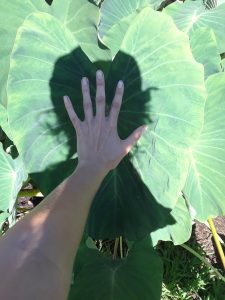
Another example of the ancients doing it right, is with POI. Kalo contains high levels of phytic acid, but the ancient Polynesians knew how to reduce it well. They knew that their food was being transformed by the act of making poi and from letting it sit in the umeke (family poi bowl) for days afterwards. The tradition was that you never entirely emptied the umeke, but always added fresh poi to mix with the well fermented poi, which presumably sped up the process of fermentation.
This is but one example of thousands of indigenous techniques now forgotten or fallen out of practice designed to enhanced the mana of food. Personally I feel that to keep these traditions alive is to feed more than just our bodies well, but the collective ‘umeke of indigenous wisdom. If we eat from this ‘aina the foods that were cultivated by our ancestors, and process the foods as they did for ourselves today, we may just remember much more of what was once lost through colonization…
Mahalo for reading!

